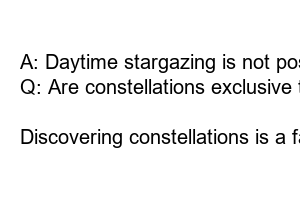별자리 찾는법
Title: How to Find Constellations: A Beginner’s Guide to Stargazing
Introduction:
Looking up at the night sky can be a mesmerizing experience, especially when you identify constellations that have captivated humanity for centuries. If you’re eager to embark on your stargazing journey, this blog post will guide you on how to find constellations in English, uncovering the secrets of the night sky.
1. Understanding the Basics of Stargazing:
To find constellations, it is essential to familiarize yourself with basic stargazing principles. Learn about the *astronomical coordinate system* and how it aids in locating stars and constellations. Familiarize yourself with the cardinal directions to orient yourself in the night sky.
2. Identifying Prominent Constellations:
Begin your stargazing adventure by locating some of the most prominent constellations. *Orion the Hunter* with his distinctive belt, *Ursa Major* and its well-known Big Dipper, and *Leo the Lion* are excellent starting points. These constellations are visible throughout the year and easily recognizable.
3. Utilize Star Maps and Mobile Apps:
Star maps and mobile apps can be invaluable tools for finding constellations. These resources provide you with accurate information about celestial objects and their locations. Some popular apps include *SkyView*, *Star Walk 2*, and *Night Sky*.
4. Locating Constellations by Season:
Certain constellations are only visible during specific seasons. Understand how the night sky changes throughout the year and which constellations become prominent during each season. For instance, Gemini, Cancer, and Leo dominate the winter sky, while Cygnus, Lyra, and Aquila shine bright in the summer.
5. Recognizing Star Patterns:
Constellations are composed of stars grouped together to form recognizable patterns. Learn to identify these patterns, which are unique to each constellation. *Connect the dots* by mentally drawing lines between the stars to reveal their shapes, making it easier to find and remember them.
6. Plan a Stargazing Trip:
Immerse yourself fully by planning a stargazing trip away from city lights. Choose a clear night and ensure you have the right equipment such as a telescope, binoculars, or even a smartphone camera. Consider joining an astronomy club or attending stargazing events for expert guidance and insights.
FAQs
Q: How long does it take to learn the constellations?
A: Learning the constellations is an ongoing process, but with dedicated practice, you can start identifying them within a few weeks.
Q: Can I spot constellations in urban areas?
A: Light pollution can make it challenging to see constellations clearly in urban areas. Opt for darker locations away from city lights.
Q: Do constellations change their positions over time?
A: Due to Earth’s rotation and its orbit around the Sun, constellations appear to shift positions slowly over thousands of years. However, these changes are imperceptible in a human lifespan.
Q: How many constellations are officially recognized?
A: The International Astronomical Union officially recognizes 88 constellations covering the entire celestial sphere.
Q: Can I observe constellations during the day?
A: Daytime stargazing is not possible due to the sun’s glare, which outshines other celestial objects. Wait until twilight or nighttime for optimal viewing conditions.
Q: Are constellations exclusive to Earth?
A: Constellations are a human construct to help navigate and identify stars. While the patterns appear the same from Earth, they vary from different vantage points in space.
Summary:
Discovering constellations is a fascinating journey that connects us to the vastness of the universe. By understanding stargazing fundamentals, familiarizing yourself with prominent constellations, utilizing resources like star maps and mobile apps, and practicing observation techniques, you’ll soon be able to confidently locate and admire the beautiful constellations that adorn our night sky. Happy stargazing!

